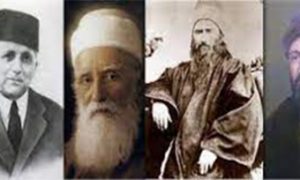The characters of the leaders of Babism and Baha’ism are as follows:
- a) Illiteracy: Sheikh Ahmad Ehsaee was claiming for taking orders from the holy Imams (peace be upon them) by dreaming, revelation and the like in each time in order for wisdom for interpreting religion not to be used.[1] His writings and ideas resemble to a dreamer more to a religious leader.[2]
Seyyed Kazem Rashti, Sheikh Ahmad’s successor was so. He says about heaven’s angels: The angels’ heads are known in each sky: the first one is Ismaeel, the second are Micheal Simon, Zeitoun, Shamoun, and Ataeel. The third are seyyed Paeel, and Zahreaeed”[3]. In this way, he names 678 ones.
Sheikh Ahmad was really interested in Shia Imams and was attributing exaggerated materials to them. He was paying more attention to hot spices such as frankincense, mastic, ginger, and lavender very much. When speaking, Sheikh Ahmad was combining the verses of the holy Quran, traditions of the holy Imams, poems of poets and speech from philosophers and talismans. So, people from various tastes and natural dispositions were interested in his speech.[4]
There was a debate between Hajj Muhammad Taqi Mamagani which ended in his excommunication.[5]
Seyyed Ali Muhammad Bab claimed for being illiterate like the holy prophet (P.H.) and possesses science! Her forged imaginary stories for them to believe.[6] While there are many documents indicating that he was educated.[7]
Bab debated several times with the scholars in Shiraz, Isfahan, and Tabriz which ended in his failure due to weak information, religious ignorance and scientific illiteracy. A group considered him ignorant and phantasmal and prevented issuing his execution verdict and another group called him apostle and merited to be hanged.[8]
[۱] Baha’ism in Iran, p. 89.
[۲] Ibid
[۳] Sharhul Qasideh, seyyed Kazem Rashti, p. 123, narrated by Baha’ism in Iran
[۴] Ibid, p.123.
[۵] The comprehensive history of Baha’ism, pp. 41 & 42.
[۶] Baha’ism in Iran, p. 127.
[۷] Ibid, pp. 293-298.
[۸] The comprehensive history of Baha’ism, pp.107-112 and pp. 116-120.






